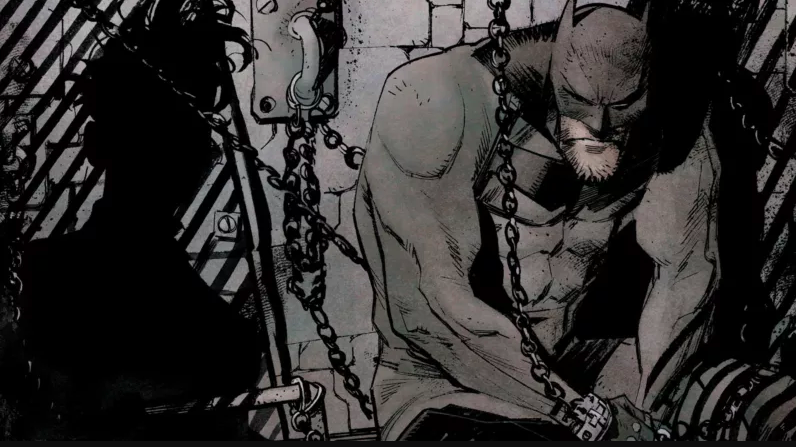Batman: White Knight graphic novel review – the Joker goes sane!
In Batman: White Knight, the newly-sane Joker tries to make Gotham great again, and Bats is really on the ropes...
The Joker goes sane! That four-word plot summary, which graces the back cover of Batman: White Knight, is proof enough that there are still original ideas to be explored in comics. DC’s Black Label imprint was set up with the sole purpose of serving up such scintillatingly fresh stories. And, as a reader, it’s eminently exciting to open up an edgy, elongated one-shot like this. White Knight, like all of its Black Label stable-mates, is a series that paints iconic DC characters into bold new corners without sacrificing the central canon.
Batman: White Knight first hit shop shelves as eight individual issues, which landed monthly between October 2017 and May 2018. If you didn’t manage to pick it up at the time, this glossy graphic novel – which collects all the issues and throws in a ton of eye-pleasing variant covers and note-covered concept drawings – is the perfect way to catch up. It’s a page-turner from the get go, which we raced through in less than a week’s worth of commute time.
From the very first page, writer and artist Sean Murphy serves up a gripping new version of Gotham. Everything seems familiar for the briefest of seconds, as the Batmobile pulls up to Arkham Asylum and a shadowy figure is solemnly welcomed in. But within a couple of pages, a striking image tells us that something is way out of whack: it was the Joker driving the Batmobile, and Batman is the one incarcerated in the asylum. Answering now to the name Jack Napier, and with a face devoid of clown makeup, the Joker enters the cell and utters some baffling words: “Batman. I need your help.”
If you enjoyed the Napier namedrop there, which harks back to the Jack Nicholson Joker from Tim Burton’s 1989 Batman film, wait ‘til you get a load of the rest of White Knight. As this status-quo-smashing narrative unfolds, Murphy liberally lobs in a wide range of nerdy references, building a world where the 1960s Batmobile is parked alongside The Dark Knight trilogy’s Tumbler in the Batcave’s garage. This may be an Elseworlds-esque standalone universe, but it feels like a valid version of Gotham that’s worthy of our attention, and it’s bound to strike all the right chords with both casual and hardcore Bat-fans.
Breaking away from that attention-grabbing opening, Murphy jumps back a year, giving himself plenty of in-story time to explain what the heck we just witnessed. We now see a game-changing battle between Gotham’s Dark Knight and The Clown Prince Of Crime, which feels like it was ripped straight out of an Arkham videogame: as Bats races across rooftops in a tank-like Batmobile, in pursuit of a hoverboard-riding Mister J, it’s incredibly easy to hear Kevin Conroy and Mark Hamill reciting their dialogue in your head.
Murphy brings us a grizzled Batman with years of experience under his gadget-stuffed utility belt, and an obsessive Joker that desperately wants to be the centre of his cowl-wearing rival’s world. It’s a dangerous dynamic, which goes off the rails incredibly quickly. Suffice it to say that the battle ends in shocking style, with some truly startling moments that we won’t spoil here, setting in motion the main events of the book and repeatedly urging the reader to rapidly turn the page.

After that, one of the best opening issues that we’ve read in ages, there are seven more excellent helpings to enjoy. Murphy spins a yarn that feels very topical, with the newly sane Joker turning his attention to the political arena and vowing to be Gotham’s White Knight.
Using (mostly) legitimate means, Napier sets about ridding the city of Batman and building a stronger foundation for Gotham – one that doesn’t depend on violent vigilantes to keep the peace. Murphy stops short of putting the words ‘make Gotham great again’ into Napier’s mouth, but the former super villain’s very public smear campaign on Batman still hits close to home (lest we forget that we live in a world where the Leader of the Free World uses Twitter to slag off his opponents).
White Knight isn’t completely without flaws, we have to admit: it’s third act somewhat loses sight of the book’s central appeal, at points, preferring to flit between multiple Batmobile battles instead of doubling down on the personal crises of its core characters. There’s also a subplot involving Mr Freeze that distracts from the entrancing Batman/Joker relationship that makes White Knight so readable.
The pros far outweigh the cons, though. Murphy’s plot is multifaceted but easy to follow, his artwork is never less than gorgeous, and the depth of the world is utterly astounding. In only eight issues, White Knight crams in thought-provoking themes, shocks aplenty, Easter Eggs at every turn, and more familiar faces than you could shake a Batarang at.
This is a version of the DC universe that feels fully fleshed-out, with various eras of allies and enemies nestling naturally in the narrative. We joyously binged our way through White Knight, and we’re very happy to hear that Murphy is most likely working on a sequel. He did some stellar work here, and we can’t wait to see how Murphy follows it up. White Knight feels like a love letter to Batman lore, albeit one that isn’t afraid to remix iconic elements to forge its own path. Bring on part 2!
The Batman: White Knight graphic novel is available for pre-order now, ahead of its release on October 9th 2018.